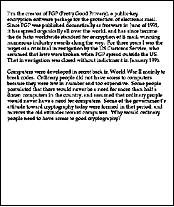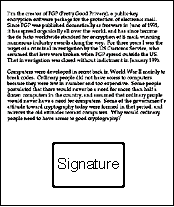数字签名是什么?
来源:互联网 发布:mac 访问共享文件夹 编辑:程序博客网 时间:2024/05/21 07:14
今天,我读到一篇好文章。
它用图片通俗易懂地解释了,"数字签名"(digital signature)和"数字证书"(digital certificate)到底是什么。
我对这些问题的理解,一直是模模糊糊的,很多细节搞不清楚。读完这篇文章后,发现思路一下子就理清了。为了加深记忆,我把文字和图片都翻译出来了。
====================================================
数字签名是什么?
作者:David Youd
翻译:阮一峰
原文网址:http://www.youdzone.com/signature.html
1.

鲍勃有两把钥匙,一把是公钥,另一把是私钥。
2.

鲍勃把公钥送给他的朋友们----帕蒂、道格、苏珊----每人一把。
3.

苏珊要给鲍勃写一封保密的信。她写完后用鲍勃的公钥加密,就可以达到保密的效果。
4.

鲍勃收信后,用私钥解密,就看到了信件内容。这里要强调的是,只要鲍勃的私钥不泄露,这封信就是安全的,即使落在别人手里,也无法解密。
5.

鲍勃给苏珊回信,决定采用"数字签名"。他写完后先用Hash函数,生成信件的摘要(digest)。
6.

然后,鲍勃使用私钥,对这个摘要加密,生成"数字签名"(signature)。
7.

鲍勃将这个签名,附在信件下面,一起发给苏珊。
8.

苏珊收信后,取下数字签名,用鲍勃的公钥解密,得到信件的摘要。由此证明,这封信确实是鲍勃发出的。
9.

苏珊再对信件本身使用Hash函数,将得到的结果,与上一步得到的摘要进行对比。如果两者一致,就证明这封信未被修改过。
10.

复杂的情况出现了。道格想欺骗苏珊,他偷偷使用了苏珊的电脑,用自己的公钥换走了鲍勃的公钥。此时,苏珊实际拥有的是道格的公钥,但是还以为这是鲍勃的公钥。因此,道格就可以冒充鲍勃,用自己的私钥做成"数字签名",写信给苏珊,让苏珊用假的鲍勃公钥进行解密。
11.

后来,苏珊感觉不对劲,发现自己无法确定公钥是否真的属于鲍勃。她想到了一个办法,要求鲍勃去找"证书中心"(certificate authority,简称CA),为公钥做认证。证书中心用自己的私钥,对鲍勃的公钥和一些相关信息一起加密,生成"数字证书"(Digital Certificate)。
12.

鲍勃拿到数字证书以后,就可以放心了。以后再给苏珊写信,只要在签名的同时,再附上数字证书就行了。
13.

苏珊收信后,用CA的公钥解开数字证书,就可以拿到鲍勃真实的公钥了,然后就能证明"数字签名"是否真的是鲍勃签的。
14.

下面,我们看一个应用"数字证书"的实例:https协议。这个协议主要用于网页加密。
15.

首先,客户端向服务器发出加密请求。
16.

服务器用自己的私钥加密网页以后,连同本身的数字证书,一起发送给客户端。
17.

客户端(浏览器)的"证书管理器",有"受信任的根证书颁发机构"列表。客户端会根据这张列表,查看解开数字证书的公钥是否在列表之内。
18.

如果数字证书记载的网址,与你正在浏览的网址不一致,就说明这张证书可能被冒用,浏览器会发出警告。
19.

如果这张数字证书不是由受信任的机构颁发的,浏览器会发出另一种警告。
20.

如果数字证书是可靠的,客户端就可以使用证书中的服务器公钥,对信息进行加密,然后与服务器交换加密信息。
(完)

Bob


(Bob's public key)
(Bob's private key)
Bob has been given two keys. One of Bob's keys is called a Public Key, the other is called a Private Key.





Anyone can get Bob's Public Key, but Bob keeps his Private Key to himselfPatDougSusan
Bob's Public key is available to anyone who needs it, but he keeps his Private Key to himself. Keys are used to encrypt information. Encrypting information means "scrambling it up", so that only a person with the appropriate key can make it readable again. Either one of Bob's two keys can encrypt data, and the other key can decrypt that data.
Susan (shown below) can encrypt a message using Bob's Public Key. Bob uses his Private Key to decrypt the message. Any of Bob's coworkers might have access to the message Susan encrypted, but without Bob's Private Key, the data is worthless.

 "Hey Bob, how about lunch at Taco Bell. I hear they have free refills!"
"Hey Bob, how about lunch at Taco Bell. I hear they have free refills!" HNFmsEm6Un BejhhyCGKOK JUxhiygSBCEiC 0QYIh/Hn3xgiK BcyLK1UcYiY lxx2lCFHDC/A
HNFmsEm6Un BejhhyCGKOK JUxhiygSBCEiC 0QYIh/Hn3xgiK BcyLK1UcYiY lxx2lCFHDC/A
 HNFmsEm6Un BejhhyCGKOK JUxhiygSBCEiC 0QYIh/Hn3xgiK BcyLK1UcYiY lxx2lCFHDC/A
HNFmsEm6Un BejhhyCGKOK JUxhiygSBCEiC 0QYIh/Hn3xgiK BcyLK1UcYiY lxx2lCFHDC/A "Hey Bob, how about lunch at Taco Bell. I hear they have free refills!"
"Hey Bob, how about lunch at Taco Bell. I hear they have free refills!"With his private key and the right software, Bob can put digital signatures on documents and other data. A digital signature is a "stamp" Bob places on the data which is unique to Bob, and is very difficult to forge. In addition, the signature assures that any changes made to the data that has been signed can not go undetected.



 To sign a document, Bob's software will crunch down the data into just a few lines by a process called "hashing". These few lines are called a message digest. (It is not possible to change a message digest back into the original data from which it was created.)
To sign a document, Bob's software will crunch down the data into just a few lines by a process called "hashing". These few lines are called a message digest. (It is not possible to change a message digest back into the original data from which it was created.)


Bob's software then encrypts the message digest with his private key. The result is the digital signature.



Finally, Bob's software appends the digital signature to document. All of the data that was hashed has been signed.





Bob now passes the document on to Pat.
 First, Pat's software decrypts the signature (using Bob's public key) changing it back into a message digest. If this worked, then it proves that Bob signed the document, because only Bob has his private key. Pat's software then hashes the document data into a message digest. If the message digest is the same as the message digest created when the signature was decrypted, then Pat knows that the signed data has not been changed.
First, Pat's software decrypts the signature (using Bob's public key) changing it back into a message digest. If this worked, then it proves that Bob signed the document, because only Bob has his private key. Pat's software then hashes the document data into a message digest. If the message digest is the same as the message digest created when the signature was decrypted, then Pat knows that the signed data has not been changed. Doug (our disgruntled employee) wishes to deceive Pat. Doug makes sure that Pat receives a signed message and a public key that appears to belong to Bob. Unbeknownst to Pat, Doug deceitfully sent a key pair he created using Bob's name. Short of receiving Bob's public key from him in person, how can Pat be sure that Bob's public key is authentic?
Doug (our disgruntled employee) wishes to deceive Pat. Doug makes sure that Pat receives a signed message and a public key that appears to belong to Bob. Unbeknownst to Pat, Doug deceitfully sent a key pair he created using Bob's name. Short of receiving Bob's public key from him in person, how can Pat be sure that Bob's public key is authentic?It just so happens that Susan works at the company's certificate authority center. Susan can create a digital certificate for Bob simply by signing Bob's public key as well as some information about Bob.
Name
Department
Cubical Number
Certificate Info:
Expiration Date
Serial Number
Bob's Public Key:





Now Bob's co-workers can check Bob's trusted certificate to make sure that his public key truly belongs to him. In fact, no one at Bob's company accepts a signature for which there does not exist a certificate generated by Susan. This gives Susan the power to revoke signatures if private keys are compromised, or no longer needed. There are even more widely accepted certificate authorities that certify Susan.
Let's say that Bob sends a signed document to Pat. To verify the signature on the document, Pat's software first uses Susan's (the certificate authority's) public key to check the signature on Bob's certificate. Successful de-encryption of the certificate proves that Susan created it. After the certificate is de-encrypted, Pat's software can check if Bob is in good standing with the certificate authority and that all of the certificate information concerning Bob's identity has not been altered.
Pat's software then takes Bob's public key from the certificate and uses it to check Bob's signature. If Bob's public key de-encrypts the signature successfully, then Pat is assured that the signature was created using Bob's private key, for Susan has certified the matching public key. And of course, if the signature is valid, then we know that Doug didn't try to change the signed content.

- 数字签名是什么?
- 数字签名是什么?
- 数字签名是什么?
- 数字签名是什么?
- 数字签名是什么?
- 数字签名是什么?
- 数字签名是什么
- 数字签名是什么?
- 数字签名是什么?
- 数字签名是什么?
- 数字签名是什么?
- 数字签名是什么?
- 数字签名是什么?
- 数字签名是什么
- 数字签名是什么?
- 数字签名是什么?
- 数字签名是什么?
- 数字签名是什么
- [DP] BZOJ1025: [SCOI2009]游戏
- 在jsp中引入java类与引入其他jsp用法
- CSDN-markdown编辑器的使用
- Spring读取数据库里面的application.perproties格式的String
- 关于STM32定时器输出方波时改变频率延时相应的问题
- 数字签名是什么?
- html列表
- 使用Hibernate SQLQuery执行原生SQL
- Java多线程基础(一)
- C++如何实现类对象只能动态分配或只能静态分配
- T1 hyf的赌约
- “Beginning Python”(六)“Plot”
- STM32菜鸟成长记录---RS485通讯协议的应用
- vim编辑器



